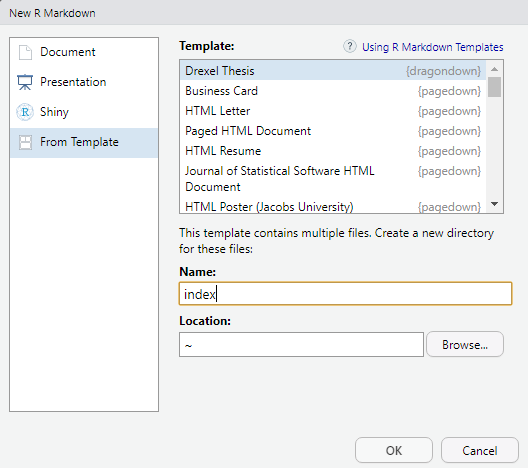This project was inspired by the thesisdown package
Currently, the PDF version is fully-functional. The gitbook, word, and epub versions are developmental, have no templates behind them, and are essentially calls to the appropriate functions in bookdown.
Under the hood, the Drexel University LaTeX template is used to ensure that documents conform precisely to submission standards. At the same time, composition and formatting can be done using lightweight markdown syntax, and R code and its output can be seamlessly included using rmarkdown.
The large majority of the drexel-thesis LaTeX document class was developed by W. Trevor King and can be found here. The drexel-thesis.cls file in this repo was created by following the instructions in their repo. A few minor changes were made to the .cls file in order to conform with the needs of this package, but for the most part, it is the same as the one they provided.
You can see what a rendering of the pdf version of the thesis will look like here
To see how to create your own custom version of dragondown and thesisdown, check out the thesisdown repo.
Most of these instructions are from Ben Marwick's huskydown package adaptation of thesisdown.
Using dragondown has some prerequisites which are described below. To compile PDF documents using R, you are going to need to have LaTeX installed. By far the easiest way to install LaTeX on any platform is with the tinytex R package:
install.packages(c('tinytex', 'rmarkdown'))
tinytex::install_tinytex()
# after restarting RStudio, confirm that you have LaTeX with
tinytex:::is_tinytex()
You may need to install a few extra LaTeX packages on your first attempt to knit as well.
To use dragondown from RStudio:
-
Ensure that you have already installed LaTeX and the fonts described above, and are using the latest version of RStudio. You can use
dragondownwithout RStudio. For example, you can write the Rmd files in your favourite text editor (e.g. Atom, Notepad++). But RStudio is probably the easiest tool for writing both R code and text in your thesis. It also provides a nice way to build your thesis while editing. We'll proceed assuming that you have decided to use the RStudio workflow. -
Install the bookdown and dragondown packages:
if (!require("remotes")) install.packages("remotes", repos = "http://cran.rstudio.org")
remotes::install_github("rstudio/bookdown")
remotes::install_github("tbradley1013/dragondown")-
Use the New R Markdown dialog to select Thesis:
Note that this will currently only Knit if you name the directory
indexas shown above. This guarantees thatindex.htmlis generated correctly for the Gitbook version of the thesis. -
After choosing which type of output you'd like in the YAML at the top of index.Rmd, Knit the
index.Rmdfile to get the book in PDF or HTML formats.
You need to edit the individual chapter R Markdown files to write your thesis. It's recommended that you version control your thesis using GitHub if possible. RStudio can also easily sync up with GitHub to make the process easier. While writing, you should git commit your work frequently, after every major activity on your thesis. For example, every few paragraphs or section of text, and after major step of analysis development. You should git push at the end of each work session before you leave your computer or change task. For gentle novice-friendly guide to getting starting with using Git with R and RStudio, see http://happygitwithr.com/.
To render your thesis into a PDF, open index.Rmd in RStudio and then click the "knit" button. To change the output formats between PDF, gitbook and Word , look at the output: field in index.Rmd and comment-out the formats you don't want.
The PDF file of your thesis will be deposited in the _book/ directory, by default.
The following components are ones you should edit to customize your thesis:
In the original implementation of the drexel-thesis class, the approval form was developed with pure LaTeX. Unfortunately, since the class was written, the approval form has been updated, and since I am not a LaTeX expert, I did not recreate the new form in pure LaTeX. In this implementation, the drexel-thesis class just includes a pdf file named docs/approval-form.pdf. This package includes a blank form from the Drexel Graduate Forms page. You can use the blank form in your output or you can either replace the default file or add a new file with the information filled in. If you add a new file, you can specify the location of the file with the YAML parameter approvalform:
approvalform: path/to/file
If you do not want to include the approval form in your thesis rendering, then you can simply open the template.tex file in your repo and remove the approvalform option from the \documentclass line. The \documentclass should now read something like this:
\documentclass[subfig,blackref]{drexel-thesis}
This is the main configuration file for your thesis. It determines what Rmd files are included in the output, and in what order. Arrange the order of your chapters in this file and ensure that the names match the names in your folders.
This file contains all the meta information that goes at the beginning of your document. You'll need to edit this to put your name on the first page, the title of your thesis, etc.
These are the Rmd files for each chapter in your dissertation. Write your thesis in these. If you're writing in RStudio, you may find the wordcount addin useful for getting word counts and readability statistics in R Markdown documents.
Store your bibliography (as bibtex files) here. We recommend using the citr addin and Zotero to efficiently manage and insert citations.
Specific style files for bibliographies should be stored here. A good source for citation styles is https://github.com/citation-style-language/styles#readme
Store your figures and data here and reference them in your R Markdown files. See the bookdown book for details on cross-referencing items using R Markdown.

